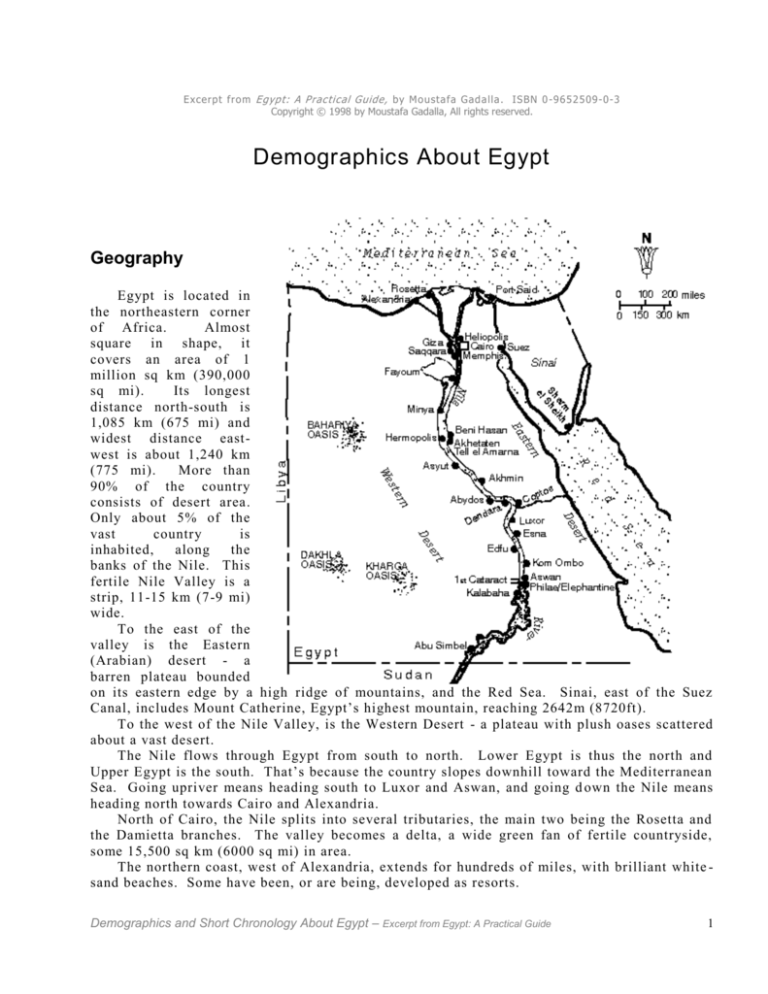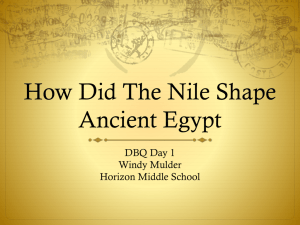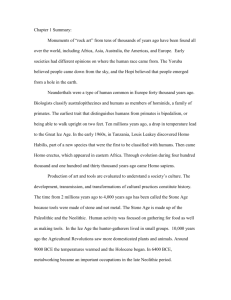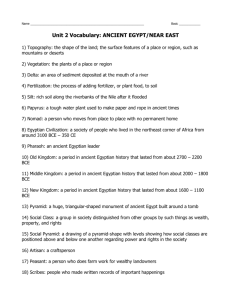
Excerpt from Egypt: A Practical Guide, by Mousta fa Gad a lla . ISBN 0 -9652509 -0-3
Copyright © 1998 by Moustafa Gadalla, All rights reserved.
Demographics About Egypt
Geography
Egypt is located in
the northeastern corner
of Africa.
Almost
square in shape, it
covers an area of 1
million sq km (390,000
sq mi).
Its longest
distance north-south is
1,085 km (675 mi) and
widest distance eastwest is about 1,240 km
(775 mi).
More than
90% of the country
consists of desert area.
Only about 5% of the
vast
country
is
inhabited,
along
the
banks of the Nile. This
fertile Nile Valley is a
strip, 11-15 km (7-9 mi)
wide.
To the east of the
valley is the Eastern
(Arabian) desert - a
barren plateau bounded
on its eastern edge by a high ridge of mountains, and the Red Sea. Sinai, east of the Suez
Canal, includes Mount Catherine, Egypt’s highest mountain, reaching 2642m (8720ft).
To the west of the Nile Valley, is the Western Desert - a plateau with plush oases scattered
about a vast desert.
The Nile flows through Egypt from south to north. Lower Egypt is thus the north and
Upper Egypt is the south. That’s because the country slopes downhill toward the Mediterranean
Sea. Going upriver means heading south to Luxor and Aswan, and going d own the Nile means
heading north towards Cairo and Alexandria.
North of Cairo, the Nile splits into several tributaries, the main two being the Rosetta and
the Damietta branches. The valley becomes a delta, a wide green fan of fertile countryside,
some 15,500 sq km (6000 sq mi) in area.
The northern coast, west of Alexandria, extends for hundreds of miles, with brilliant white sand beaches. Some have been, or are being, developed as resorts.
Demographics and Short Chronology About Egypt – Excerpt from Egypt: A Practical Guide
1
Weather
Autumn and winter are the ideal seasons to visit Egypt when mild weather prevails,
temperatures vary between 16 o C (60 o F) and 27 o C (80 o F). Evenings are cool. Prolonged rain is
uncommon, except in Alexandria in the winter, but showers may fall elsewhere between October
and April.
During April, an occasional hot sand wind blows which can make sightseeing less
enjoyable.
The summer months are hot, 27-38 o C (80-105 o F); however, the air is dry and humidity
low. The relative humidity, in Egypt, ranges from 30 -60%.
In Alexandria, on the Mediterranean Sea, the months of December through February are
rainy and cold. October to April represents the best time, with water temperatures of 16 -22 o C
(60-70 o F).
Sinai has unique weather. The desert is typically hot during the day and cold at night, but
the mountains can be chilly, even during the day.
Language
Arabic is Egypt’s official language.
However, most
Egyptians understand and speak English and French. In larger
towns, the foreign visitor will encounter no difficulty in communicating with the people.
Arabic is written from right to left. Its alphabet contains 28 letters. The Arabic sentence
above reads “Egypt: Center [of] Civilization”.
Population & People
In 1998, Egypt’s population totaled 65 million. About 90% of Egyptians are concentrated
in the fertile Nile Valley, and live in 5% of the country’s territory — 44% in urban areas and
most in some 4,000 villages. Cairo, Egypt’s capital, has 14 million inhabitants, and Alexandria,
the country’s second largest city, has a population of 5.5 million .
The population increases at a rate of one million every ten months. As a result, 50% of the
population is now under 18 years of age. As a consequence, the public services and
infrastructure are under a great strain.
The Egyptians are outgoing, warm and have a distinct sense of humor. They have respect
and a liking for foreigners.
Demographics and Short Chronology About Egypt – Excerpt from Egypt: A Practical Guide
2
Religions
Approximately 85% of the population of Egypt are Moslems. Most of the rest are Christian
Orthodox, who belong to the Coptic Church. There is also a small Jewi sh community, still
residing in Egypt.
Islam
Islam means ‘submission’. The Moslems believe in the one God, Allah, AND that
Mohammed is his prophet. Allah is an Arabic word, meaning “Who has everything”. According
to Islamic traditions, Moslem follower s are encouraged to spread the word, even by force if
necessary.
Moslems have five main acts to follow, as directed by the Koran (Qur’an), the Moslem’s
holy book. These Five Pillars of Faith are:
1. The Moslem must publicly declare that ‘There is no God but Allah and Mohammed is
his Messenger’. These two go hand in hand. You can’t have one without the other.
2. The Moslem must pray five times a day, at specific times between dawn and early
evening. A person can pray anywhere. Only male Moslems are required to attend the
Friday noon mass prayer at the mosque.
3. Moslems are required to give a certain percentage of their wealth to zakah(charity), for
the needy, and to further the cause of Islam.
4. Moslems must fast from dawn to sunset, during the Islamic lunar mont h of Ramadan.
5. At least once in a lifetime, the Moslem must make the haj, or pilgrimage to Mecca, if at
all possible.
Throughout Egypt, you will notice the mosques’ thin towering minarets, some as high as
80m (260ft). These are used by the mosque official s, known as mu-azzen, to announce the call
to prayer. Faithful Moslems follow the call and may stop what they are doing, go off into
another room, or to the mosque, and begin their prayers.
Mosques are built so that they point towards Mecca. When a Moslem enters a mosque, he
removes his shoes, and washes himself in a certain way, then commences to pray.
Prayers are a pre-defined set of routines, to be followed in the same order each time. The
worshipper faces the direction of Mecca, bows, kneels, places h is palms on the ground, then his
nose and forehead. He then stands, and repeats the cycle for a specific number of times.
Visiting Mosques - You can only visit mosques designated by the Ministry of Tourism as
‘tourist sites’, and not during times of pray er. You must dress modestly (men - no shorts,
women - no shorts or sexy clothing). Use common sense and respect. Remove your shoes or
‘rent’ the shoe coverings available at the entrance to the mosque.
Egyptian Coptic Christianity
In 333 CE, Christianity became the religion of the Roman Empire. A short time later, the
Empire split. Egypt became part of the Eastern (or Byzantine) Empire. Dioscurus, the patriarch
of Alexandria, refused to accept the Byzantine Christian doctrine. He believed that Chris t is
Demographics and Short Chronology About Egypt – Excerpt from Egypt: A Practical Guide
3
totally divine, and that it is blasphemous to consider Him human. Since that time, Egyptian
Christians have been referred to as Coptic Christians.
‘Copt’ is derived from the Greek rendering for an Egyptian. The Arabs, after 640 CE,
labeled non-Moslems as Copts. As a result, the term ‘Coptic Church’ took on a different
meaning by the 7 t h century.
Judaism
Egypt currently has fewer than 500 Jews, mostly elderly, scattered through Alexandria,
Cairo, and El Minya, near the capital city of Pharaoh Akhen aton. There were more than 80,000
Jews in Egypt until 1948. After the independence of Israel and the animosities in the region,
their number dwindled to a trickle.
Economy
Before the 1952 revolution, Egypt’s economy depended mainly on agriculture. Egypt is
expanding its inhabitable land by using new irrigation methods, and encouraging people to
relocate to the new land reclamation areas.
Today, tourism is the main source of revenue, and there are many exports, such as oil,
textiles, canned foods, and cotton goods. The Suez Canal is also a sizeable source of income,
with about 50 ships a day paying fees.
Agriculture
Egypt continues to produce high quality agricultural products, such as rice, sugar cane,
fruits, vegetables, and cotton. The Nile V alley has highly fertile soil, and you will see the
results, if you chance upon a Farmers’ Market, or notice the enormous, colorful fruits and
vegetables in small vendors’ carts everywhere.
Education
The education system is composed of four stages - primary (years 1-6), preparatory (years
7-9), secondary (years 10 -12), and university. Primary education is mandatory and is extended
to children between the ages of six and twelve. Education in Egypt is provided free to all
Egyptians. However, it is highly competitive at the university level, to get the institution and
major of your choice.
Demographics and Short Chronology About Egypt – Excerpt from Egypt: A Practical Guide
4
Names of Places
In Egypt, you will find that a place, or an ancient name/reference, may have several names:
its Pharaonic (original), Greek rendering, which got p opularized worldwide, and Arabic, which
was given to it after the 640 CE invasion of Egypt. Throughout this book, the real, legitimate
name, i.e. Pharaonic, will be shown in bold italics. Other common names will be shown in
regular italics. Nobody likes his/her name arbitrarily and disrespectfully changed.
Demographics and Short Chronology About Egypt – Excerpt from Egypt: A Practical Guide
5
Excerpt from Egypt: A Practical Guide, by Mousta fa Gad a lla . ISBN 0 -9652509 -0-3
Copyright © 1998 by Moustafa Gadalla, All rights reserved.
A Short Chronology of Egyptian History
Below, is a rough summary of the main periods of Egypt’s history:
Pre-Dynastic Pharaonic Egypt
Dynastic Pharaonic Times
Greek Rule
Roman & Byzantine Rule
The Arab Rule
Turkish Rule
British Occupation
Independent Egypt
( ?? - 3200 BCE)
(3200-343 BCE)
(332 - 30 BCE)
(30 BCE - 640 CE)
(640 - 1517)
(1517 - 1882)
(1882 - 1956)
(1952 onwards)
BCE denotes Before Common Era, also noted in other references as B.C.
CE denotes Common Era, also noted in other references as A.D.
Pre-Dynastic Era (?? - 3200 BCE)
How old is Egypt, you might ask?
The Greek and Roman writers of antiquity, basing their accounts on information received
either first or second-hand from Egyptian sources, claimed a far greater antiquity for th e
Egyptian civilization than that currently established by Academic Egyptologists.
These
Egyptian sources called for antiquity ranging from 24,000 and 36,000 years during which Egypt
was civilized.
Herodotus reported that he was informed by Egyptian prie sts that the sun had twice set
where it now rose, and twice risen where it now set. Egyptologist Schwaller de Lubicz
explained the statement to mean that it may be a reference to the progressional cycles of the
equinox.
The progression results in the ris ing against a different sign of the Zodiac
approximately every two thousand years. This would mean that the Egyptians counted their
history back for at least a cycle and a half, some 36,000 years. This is in a general agreement
with other accounts and evidential findings throughout Egypt.
Demographics and Short Chronology About Egypt – Excerpt from Egypt: A Practical Guide
6
Even though the above reports were current in those Late Kingdom and Ptolemaic days,
most Academic Egyptologists continue ignoring them because they lack physical evidence to
support an antiquity of this order. Since s uch remote antiquity is hard to handle, they ascribe
these legendary millennia to the Egyptian imagination. It is, however, difficult to provide
convincing archaeological evidence that is older than 5,000 to 7,000 years or longer, because
nothing of meaningful value can logically survive such a long time. Circumstantial evidence,
from varied historical sources, can be as strong or even stronger than physical archaeological
evidence. As such, we should continue to mention the different sources of informat ion, and not
to arbitrarily choose to ignore or accept them.
The Greco-Egyptian historian Manetho (3 rd century BCE), under the early Ptolemies, wrote
the only substantive history of Egypt to come down to us. He gathered his information from
Egyptian records. A few pre-dynastic inscribed tablets and papyri have been found, but all were
incomplete because of their remote age. Manetho acknowledged greater antiquity of the
Egyptian history. However, because of the overwhelming task, he chose Mena(Menes) as a
starting point, about 3000 years earlier.
The Glorious Pharaonic Era [Dynastic Egypt] (3200-343 BCE)
Manetho started with Mena(Menes) and then divided the entire chronicle of events into
thirty-one dynasties, from Mena(Menes) to the conquest of Alexander the Great in 332 BCE.
Manetho’s list of kings and their years of rule have been preserved in the writings of early
Christian record keepers. Modern historians selectively use such records, and accept the
numbering of Manetho’s dynasties, whi ch seems to follow very ancient practice. They also
continue to use the Greek versions of the pharaohs’ and ancient sites’ names.
We, however, in this book, will use the legitimate Egyptian names in bold italics. In order
not to burden the readers, other names given arbitrarily and disrespectfully by the Greeks and
Arabs, will be shown in regular italics.
The 31 Dynasties of Manetho, have been further grouped by modern historians into larger
time-spans, so as to coincide with distinct cultural patterns, separated by unknown periods of
political uncertainties. Sometimes these periods are further sub -divided.
Estimated dates for the dynasties are given below. Those before the 26 t h Dynasty are
approximations. The dates of individual kings, queens and ot her individuals mentioned in the
book will be found throughout the book, in conjunction with each subject.
Neolithic Period - before 5000 BCE
Pre-Dynastic Period - c. 5000-3300 BCE
Proto-Dynastic Period - c. 3300-3050 BCE
Demographics and Short Chronology About Egypt – Excerpt from Egypt: A Practical Guide
7
Dynasty
Dates
I
II
III
3050 BCE - 2890 BCE
2890 BCE - 2649 BCE
2649 BCE - 2575 BCE
Early
Dynastic
Period
IV
V
VI
VII-X - 1st Interm.
Period
2575
2465
2323
2150
Old
Kingdom
XI
XII
XIII-XVII - 2nd Interm.
Period
XVIII
XIX
XX
2040 BCE - 1991 BCE
1991 BCE - 1783 BCE
1783 BCE - 1550 BCE
Middle
Kingdom
1550 BCE - 1307 BCE
1307 BCE - 1196 BCE
1196 BCE - 1070 BCE
New
Kingdom
XXI (Tanis)
XXII (Libyan)
XXIII (Nubia&Thebes)
XXIV (Sais)
1070
945
878
740
BCE
BCE
BCE
BCE
-
712
712
712
712
BCE
BCE
BCE
BCE
Third
Interm.
Period
712
657
525
404
399
380
343
BCE
BCE
BCE
BCE
BCE
BCE
BCE
-
657
525
404
399
380
343
332
BCE
BCE
BCE
BCE
BCE
BCE
BCE
332
323
30
323
BCE
BCE
BCE
CE
XXV (Nubia &Thebes)
XXVI (Sais)
XXVII (Persian)
XXVIII (Sais)
XXIX
XXX
Second Persian Period
Macedonian Kings
Ptolemic Dynasty
Roman Emperors
Byzantine Emperors
BCE
BCE
BCE
BCE
-
2465
2323
2150
2040
BCE
BCE
BCE
BCE
- 304 BCE
- 30 BCE
- 323 CE
- 640 CE
Late
Kingdom
GrecoRoman
Period
Ptolemaic Era (332-30 BCE)
Alexander the Great entered Egypt unopposed. He was even welcomed by the Egyptians,
who wanted help getting rid of the Persian occupie rs, at any cost. He founded the city of
Alexandria. After his death, the Ptolemaic Dynasty was founded, and Alexandria flourished.
Disputes and Ptolemies’ in-fighting ended their rule, about the time of Cleopatra’s suicide.
Afterwards, Egypt became a Roman Province.
Demographics and Short Chronology About Egypt – Excerpt from Egypt: A Practical Guide
8
Roman & Byzantine Rule (30 BCE -640 CE)
Egypt became a Roman colony, and was made the granary of the Roman Empire. The
Romans succeeded in protecting the Egyptian borders.
Shortly after Christianity was declared the state religion, in the 4 t h century, the Roman
Empire split in half. The eastern half became what was later known as the Byzantine or Eastern
Empire. It was ruled from Constantinople (now Istanbul), while the Western Roman Empire
remained centered in Rome.
The Byzantines continued to successfully protect the Egyptian borders, until 640 CE, when
the Arabs arrived.
Arab Rule (640-1517)
The Arabs entered Egypt, in 640 CE, and made Egypt an Arab colony with Islam as its
religion, and Arabic as its language. This was the d evastating blow to ancient Egypt.
In 658 CE, the Omayyads, an Arab dynasty based in Damascus, snatched control of Egypt
and stayed in power until 750 CE. For the next 108 years Egypt was ruled by the Baghdad based Abbasid Dynasty.
Arabic Islamic dynasties then made Cairo their capital city, and kept changing hands,
killing each other, to take over power, until the Turkish soldiers arrived.
Turkish Rule (1517-1882)
In 1517, Egypt was invaded by Ottoman sultans, who relied on Mamelouks (slaves) to
govern the country.
In 1798, Napoleon conquered Egypt, but left three years later.
An Albanian officer in the Ottoman service, called Mohamed Ali, declared himself ruler of
the Egypt. During his reign (1805 -1849), Egypt made progressive changes. However, u nder the
rule of his grandson, Khedive Ismail, his financial mis -management led to the British invasion
of Egypt, in 1882 CE.
Demographics and Short Chronology About Egypt – Excerpt from Egypt: A Practical Guide
9
British Occupation (1882-1956)
The British maintained their forces throughout the whole country. But gradually, their
military forces shrank from populated areas, to station near the Suez Canal, until a total
withdrawal treaty was signed, and all the British forces left Egypt, in 1956.
Independent Egypt
In 1952, the royal dynasty established by Mohamed Ali came to an end wh en a group of
army officers forced the abdication of King Farouk. It was the first time in about 2,000 years,
that Egyptians finally ruled themselves - not as in the Pharaonic time, but under the domination
of Arabic/Islamic traditions.
In 1954, Egypt was proclaimed a republic, and Gamel Abdel -Nasser became her president.
After his death in 1970, Nasser was succeeded by Mohamed Anwar El -Sadat, who was
assassinated in 1981. Mohamed Hosni Moubarak was elected to Presidency, at this time, and
was re-elected when his seven year term expired.
Demographics and Short Chronology About Egypt – Excerpt from Egypt: A Practical Guide
10









